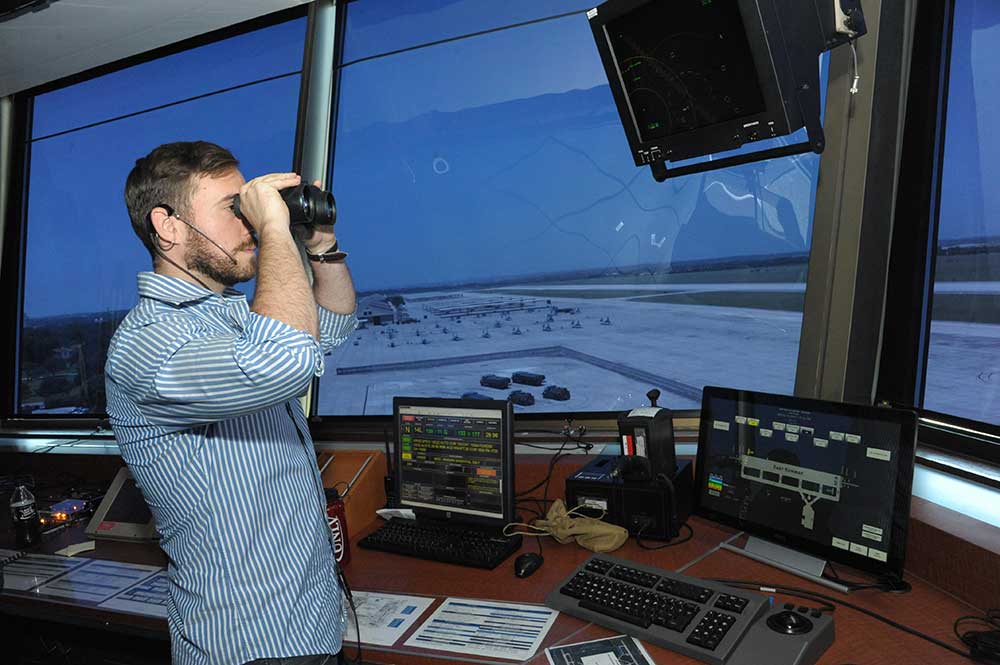Disclaimer: The information on our website is provided for general information purposes only. We make no representations or warranties of any kind, express or implied, about the completeness, accuracy, reliability, suitability or availability with respect to the website or the information contained on our website for any purpose. Any reliance on such information is therefore strictly at your own risk and we are not liable for any damages or losses arising out of or resulting from your reliance on any information contained on our website.
An air traffic controller works from control towers, approach control facilities, or route centers to give aircraft clearances to take off or land safely. They coordinate air traffic patterns to assure that aircrafts are safe distances apart. They have the responsibility of keeping aircrafts, flight crews, and airline passengers safe therefore are authorized to change flight paths as necessary.
Watch a video to learn what an air traffic controller does:
How to Become an Air Traffic Controller

Prior to receiving official training as an air traffic controller, you are required to have some sort of formal education or employment experience. This can include a bachelor’s degree, related work experience, or a combination of the two with a minimum of three years total. Once you meet those requirements you can apply to become an air traffic controller.
In order to become an air traffic controller you must complete several steps. First you must attend an Air Traffic Collegiate Training Initiative (AT-CTI) program, then you must pass various assessments, and only then are you considered for a Federal Aviation Administration (FAA) training program. These pre-employment requirements, training programs, and tests have specific guidelines set by the FAA. AT-CTI programs can last anywhere from 2-4 years and designed to educate applicants hoping for jobs in the air traffic control industry. Training includes reading maps, aviation weather patterns, federal regulations, airspace allowances, flying clearances, and other relevant information regarding aviation.
An applicant must also pass a personality test and an aviation aptitude test. These tests determine your skills and behavioral response patterns. In addition there is a medical exam and a background check you must pass. You are required to be a United States citizen and enter the program prior to turning 31 years old. Once all of these requirements are successfully met, you can be considered for the FAA training program. This is the last step to entering this occupational industry. It is a rigorous program that includes aviation coursework and hands-on experience. The program’s training length varies pending on the position you are seeking.
Job Description of an Air Traffic Controller
An air traffic controller is responsible for controlling all ground traffic at airports. This include incoming and outgoing planes, airport workers, maintenance, and baggage vehicles. They issue landing and take off instructions to pilots and monitor and/or direct aircraft movements both in the air and the on ground through the use of computers, visual references, and radars. Air traffic controllers oversee communications by accepting incoming flights and transferring control of departing flights to other traffic control centers. They must provide weather updates or other relevant information to pilots and be ready to authorize necessary flight path changes. An air traffic controller must be skilled in math, problem-solving, communication, and decision making.
In the event of an emergency, the air traffic controller must notify proper authorities and alert emergency response staff as soon as possible. He or she must have total concentration, be able to multi-task, and are on constant alert. It can be very stressful at times due to the responsibility of the safety of aircrafts, it’s crew, and airline passengers. Air traffic controllers must be able to be focused and concentrate for long periods of times and usually work full-time. Hours and days vary to include shift work, nights, and weekends.
Free Student and Teacher Resources
The National Air Traffic Controllers Association (NATCA) hosts free classroom materials, just visit the natca.org website’s kids corner page.
Air Traffic Controller Career Video Transcript
Watching blips on radar screens can make it seem like playing a video game, but each number on screen represents an aircraft and the safety of flights depends on the careful, decisive guidance of air traffic controllers. These professionals typically work in the airport control tower to direct the flow of planes and passengers, whether on the ground, taking off, or coming in for a landing.
Safety is their main priority but air traffic controllers also try to minimize delays. Each controller is part of a nationwide system, responding to weather, mechanical difficulties, and all the small things that can cause big problems for pre-arranged flights. They must follow procedures to the letter, adapt to new circumstances continuously, and communicate clearly.
Most air traffic controllers in the United States are trained at the Federal Aviation Administration Academy. Trainees must start training before age 31, have U.S. citizenship, and pass several evaluations including an assessment of their ability to cope with mental stress over long hours. An aviation background is a plus. With the unusual characteristic of mandatory retirement at age 56, and typically excellent pay and benefits, this can be an attractive career that demands concentrated focus. Like the intricate cogs of a Swiss watch, air traffic controllers are part of an elegant choreography that makes air travel safe and speedy.
Article Citations
- Bureau of Labor Statistics, U.S. Department of Labor, Occupational Outlook Handbook, Air Traffic Controllers.
- National Center for O*NET Development. 53-2021.00. O*NET OnLine.
- The career video is Public Domain from the U. S. Department of Labor, Employment and Training Administration.

